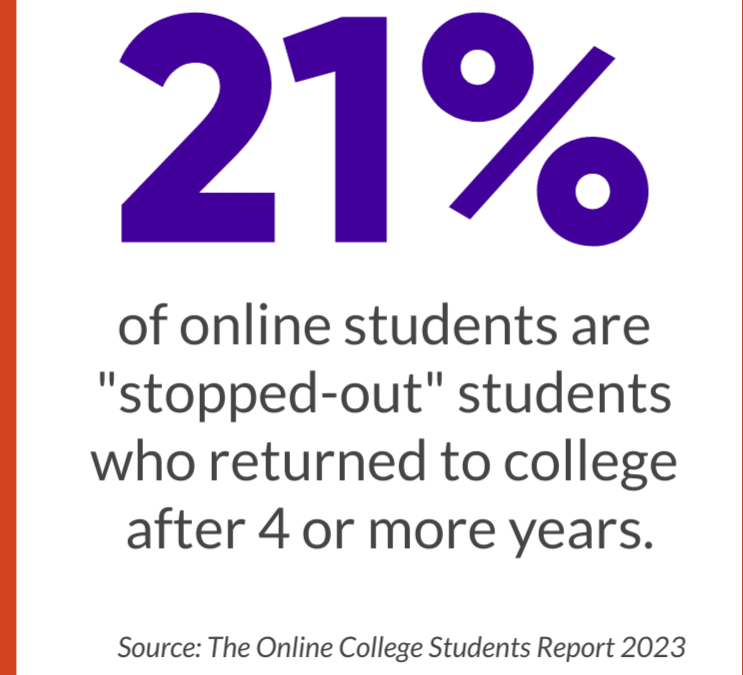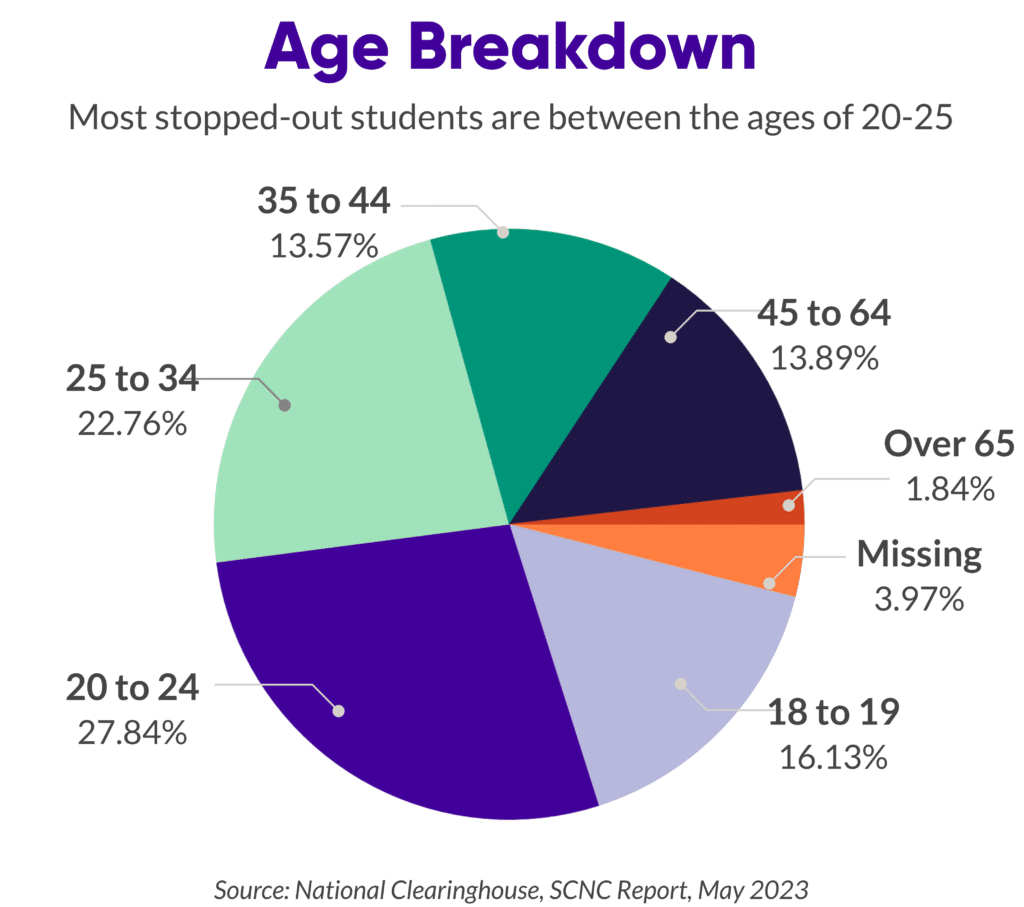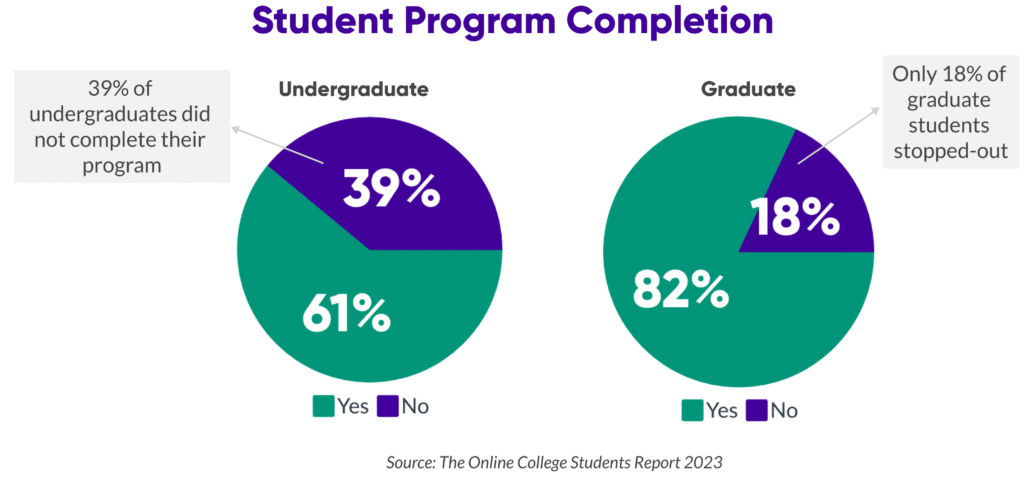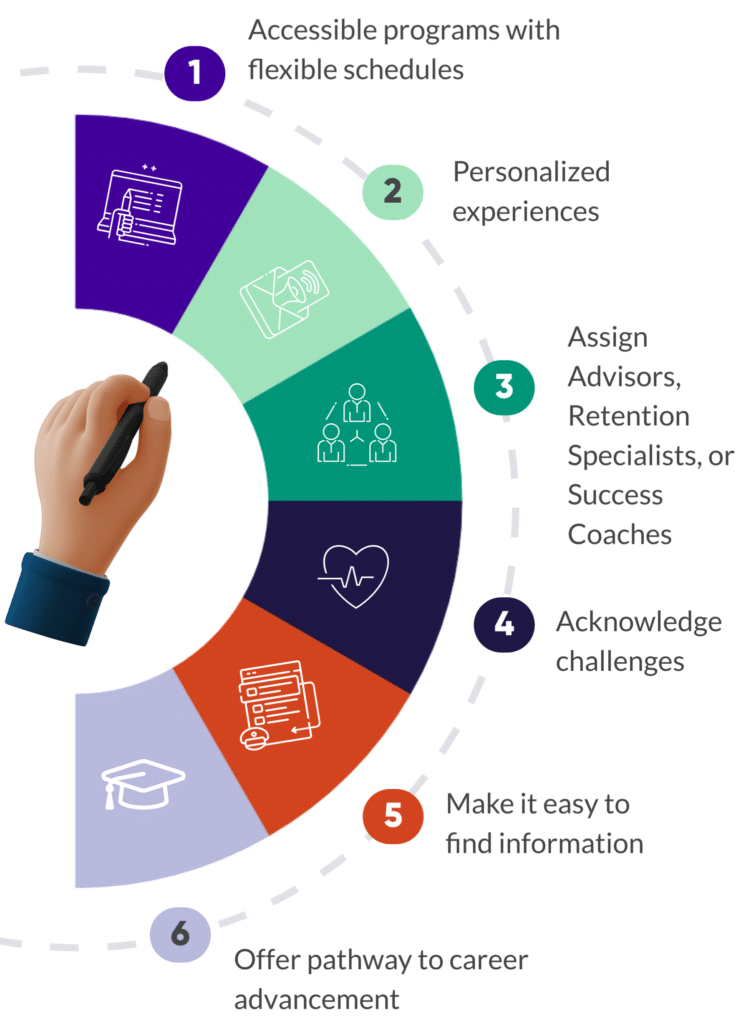Gaining Deeper Insights into Stopped-Out Students

Creating a Supportive Environment for Stopped-Out Students
The school year is in full swing, but educators and administrators are also actively focusing on students who have yet to re-engage with their virtual classrooms for quite some time. These students, referred to as “stopped-out,” make up a substantial portion of the 39 million individuals (about twice the population of New York) who have momentarily halted their academic pursuits. They may have stopped out due to financial difficulties, academic challenges, personal or family issues, or other reasons. While many stopped-out students intend to return to school, they often face barriers to re-enrollment.
Colleges and universities play a vital role in supporting stopped-out students and helping them achieve their educational goals. By creating a supportive environment, institutions can increase the likelihood that these students will re-enroll and complete their degrees. This includes understanding the needs of stopped-out students and the reasons why students stop out in the first place.
The remainder of this article will provide deeper insight into this unique student population and offer strategies to help reengage them.

Understanding the Profile of Stopped-Out Students
What does it mean to be “stopped-out” as a student?
Life can be unpredictable, and “stop-outs” know this all too well. A stopped-out college student is someone who, for various reasons, temporarily hit pause on the pursuit of their degrees or credentials. The reasons for pausing range from personal responsibilities, financial constraints, health issues, or even a change in priorities. However, their unwavering determination to return to their educational path is what truly sets them apart. To meet the challenge presented by these circumstances, colleges are re-evaluating their strategy for finding, re-enrolling, and supporting their cohort of learners to graduation.

Stopped-out students, often referred to as “Some College, No Credential (SCNC)” students, have a few key characteristics. First and foremost, there is a notable gender disparity within this group, with a slight predominance of women. Many of them, about 44%, left postsecondary education before reaching the age of 25. Most of these students were last enrolled in a community college, indicating the critical role these institutions play in accommodating and retaining this demographic.
In terms of racial and ethnic diversity, stopped-out students exhibit a higher proportion of minority representation compared to current undergraduates. In particular, Latinx and Black students comprise a more significant portion of this group, shedding light on the disparities faced by underrepresented communities within higher education. The age group with the most potential completers, meaning those who have the capability to complete their education, is 20-24 years old, making up over half of this group. The second-largest group is 25 to 34 years old.
Stopped-out students represent a considerable portion of the student population. By comprehensively analyzing this diverse demographic, institutions can gain valuable insights into the factors that hinder student retention and graduation rates. Colleges and universities can elevate their efforts to support students by understanding their unique needs and integrating a human-focused intentional approach into their outreach, engagement and support strategies.
Undergraduate and Graduate Stopped-out Student Populations
Undergraduate and graduate stop-outs may share a familiar spirit of resilience and determination, but their challenges and motivations vary. Notably, 82% of graduate students completed their last program before returning to school, which is significantly higher than the 61% completion rate among undergraduates. This indicates that undergraduate students are more likely to be stopped-out students.
Undergraduate stop-outs may face financial and personal challenges that force them to take a break from school. They may be young and inexperienced and need a clear plan for their future. Their motivations for returning to school often include wanting to finish their degree, get a better job, or pursue their passion.
Graduate stop-outs, on the other hand, may have already completed their undergraduate degree and started their careers. They may stop-out to raise a family, change careers, or care for sick family members.
Graduate students are less likely to stop-out than undergraduate students because of the clarity of their academic and career goals. Their motivations for returning to school may include advancing their careers, gaining new skills, making a career change, or improving the institutional graduation rate.

When do Stopped-out Students Stop out and Re-enroll?
The timeline can fluctuate when it comes to returning to higher education after stopping out. The data shows that stop-outs are most likely to return within a year, with more than half of them doing so. Higher education institutions can help them do this by offering flexible program options and holistic support programs that encourage and empower them to overcome obstacles and pursue their goal. This approach can improve student retention rates and help struggling students get back on track to completion.
The key to a successful stop-out campaign is to reach out to students early, often and with purpose. By personalizing your outreach and providing students with the support they need, you can increase the chances of them returning to school.
Six Strategies to Empower Stopped-out Students
Stopped-out college students who have taken a hiatus from their education come back to higher education institutions with a distinctive set of demands and expectations driven by the fear of not being able to persist and achieve their dream of graduating. Your institution’s ability to meet them where they are with student-focused strategies and personalized support can empower them to believe in themselves overcome challenges along the way and re-enroll.
Here are a few tips to personalize student support and help create an inclusive environment for stopped-out students;
- Offer easily accessible programs with flexible schedules
Stopped-out students often have busy lives with work, family, and other commitments. They need programs that fit their needs, whether online, evening, or weekend and provide them the opportunity to complete work alongside their demanding and packed schedules. - Provide personalized, meaningful and impactful experiences
Stopped-out students seek to be acknowledged as unique individuals with distinct needs and goals. They value personalized advising plans, workshops, and support services to overcome challenges and build confidence in their abilities. - Assign support from Advisors, Retention Specialists or Success Coaches
Success coaches play a critical role in helping students who stop-out succeed. They can provide guidance on financial aid, program options, and the logistics of returning to school. They can also offer encouragement and support throughout the student’s experience. - Acknowledge unique challenges
Stop-outs often face unique challenges, such as being a single parent, veteran, or disability. It’s essential for institutions to acknowledge these challenges and offer tailored support that allows them to meet their life and work demands, coach them through overwhelm and encourage them when completing feels impossible. - Make it easy to find critical information
Stopped-out students need clear, concise information about programs, admissions, and resources. The website should be where they can find this information easily and quickly. - Offer a pathway to career advancement
Many stopped-out students seek programs to help them advance their careers and achieve their professional goals.

Strategies and Tools to Track and Guide Stopped-Out Students to Graduation
Reconnecting with stopped-out students and guiding them back onto their path to graduation requires approaching the conversation with thought, empathy and understanding. These students often face unique challenges and needs, requiring a thoughtful approach that blends empathy with data-driven solutions.
Implementing an intentional, student-focused and scalable outreach plan to effectively track the engagement and progress of re-enrolled students allows institutions to proactively provide individualized and necessary support.
An effective outreach strategy includes motivational strategies, personalized advising, and a range of tools tailored to the unique needs of this student population, which can make all the difference in re-engaging and guiding these students to successful degree completion.
Here are some strategies and tools institutions can effectively track the progress of re-enrolled students:
- Student Information Systems (SIS): Use SIS platforms to maintain comprehensive student records, academic histories, and enrollment data.
- Academic Advising: Offer personalized guidance through academic advisors who track and support re-enrolled students.
- Regular Check-Ins: Establish routine meetings with re-enrolled students to monitor their academic journey and address any challenges.
- Performance Metrics and Key Performance Indicators (KPIs): Set and measure key performance indicators to assess student progress and identify areas for improvement.
- Customer Relationship Management Systems (CRMs): Use CRMs to manage interactions and communications with re-enrolled students, ensuring a seamless experience.
- Feedback Mechanisms: Collect feedback through surveys and assessments to gain insights into student satisfaction and areas needing enhancement.
- Intervention and Support Strategies: Develop proactive intervention plans to assist students facing academic difficulties or obstacles.
- Degree Audit Systems: Implement degree audit systems to help students track their progress toward degree completion.
- Success Stories: Showcase success stories of re-enrolled students to inspire and motivate others on their educational journeys.
Your Path to Improved Student Persistence
Understanding the unique challenges of stopped-out students, providing program flexibility, and offering personalized support are essential for re-engaging and retaining stopped-out students.
To better understand these unique challenges and adapt to the changing student needs, consider partnering with experts who specialize in student success coaching and consulting. Outside support is helpful to learning ways your institution can optimize existing resources, build infrastructure, and streamline processes that allow your team to meet the student where they are on their unique journey and help them accomplish their goal of earning their degree.